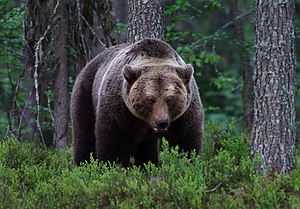Brown bear
| Brown Bear | ||||||||||||||
|---|---|---|---|---|---|---|---|---|---|---|---|---|---|---|
| Conservation status | ||||||||||||||
| Scientific classification | ||||||||||||||
| ||||||||||||||
| Binomial name | ||||||||||||||
| Ursus arctos (Linnaeus, 1758) |
The brown bear (Ursus arctos) is a species of bear found in large parts of northern Eurasia and North America. It weighs 100 to 680 kilograms and is the second largest species of the bear family (after the polar bear).
Characteristics and Behavior
Brown bears are massive animals, males weighing from 300 to 780 kg and measuring 1.7 to 2.2 m in length. Females weigh 200 to 500 kg.
Brown bears gain up to 180 kg of fat over summer, which is spent over the winter when they become lethargic and use to den in protected spots. They are not full hibernators and can be woken easily. The body temperature is lowered by about 6 degrees during hibernation, and they can loose 30 to 50% of total body weight at this time.
They are omnivores. Their main dietary consists of various plant parts (berries, roots sprouts, fungi), fish, insects, and small mammals. They are not highly carnivorous, and their diet varies enormously based on opportunity. Occasionally they prey on large mammals, such as deer, elk, moose, and caribou. They also feed on carrion and sometimes intimidate other predators from their kills.
Distribution
Brown bear is distributed in large areas of North America, Europe and Asia. The largest populations are in Russia, the United States of America (where the largest population is in Alaska), and Canada.
In Europe there are preserved populations in several separated areas. The strongest populations are in Russia and the Carpathian Mountains. There is a stable population in Finland, Sweden and Norway. Another stable population is the Balkan population that stretches over parts of North-East Italy, Slovenia, Croatia, Bosnia and Herzegovina, Serbia, Montenegro, Macedonia, Albania and Greece.

